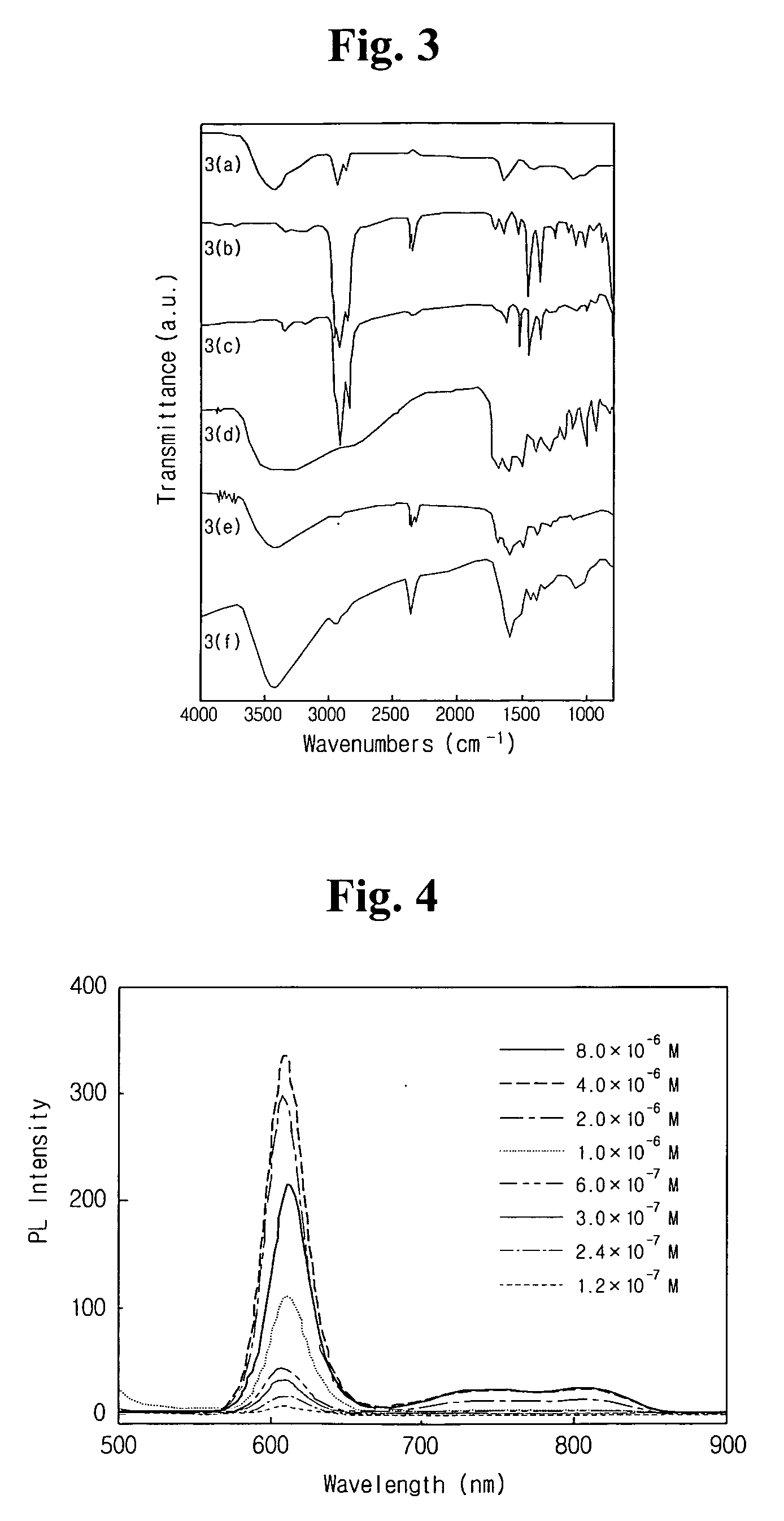Single nanoparticle containing organic-inorganic composite material and method of preparing the same
a composite material and organic-inorganic technology, applied in the field of single nanoparticle containing organic-inorganic composite material and the field of preparation of the same, can solve the problems of low quantum efficiency, poor conversion yield, size polydispersity, etc., and achieve the effect of large quantity and high conversion yield
- Summary
- Abstract
- Description
- Claims
- Application Information
AI Technical Summary
Benefits of technology
Problems solved by technology
Method used
Image
Examples
example 1
Preparation of Hydrophilic Semiconductor Nanoparticle CdSe / CdS-AET
[0070]5 ml of a hydrophobic CdSe / CdS (2.5 layers) quantum dot solution (2×10−5 M) was dispersed in 25 ml of chloroform, a methanol solution containing 0.05 M of HSCH2CH2NH2.HCl (Across, 98%, AET.HCl) was added thereto, and the mixture was vigorously stirred, yielding precipitation. When the precipitation does not occur any further, distilled water was added to the resulting mixture, thereby transferring CdSe / CdS-AET modified its hydrophobic surface into hydrophilic to an aqueous layer (upper layer). There was no precipitation or photoluminescence in the chloroform layer, which means that there was no loss of quantum dots.
[0071]The aqueous layer taken therefrom was mixed with a solvent mixture of methanol and ethyl acetate to induce precipitation and then subjected to centrifugation to separate a precipitate. The separated precipitate was washed with the solvent mixture of ethanol and ethyl acetate and dispersed in dis...
example 2
Preparation of Organic-Inorganic Composite Material CdSe / CdS-AET-PEG5000
[0073]10 ml of CdSe / CdS-AET nanoparticle solution prepared in Example 1 adjusted its concentration to 2×10−6 M and treated in a sonication bath. After sonication, it was observed that there was no broad trap state emission around 700 to 850 nm range. After 0.02 g of poly(ethylene glycol) monomethyl ether mono(succinimidyl succinate) ester (PEG5000, Polyscience Inc., Mw=5000) (200 equivalents) was dissolved in 2 ml of acetonitrile, it was added to the diluted nanoparticle solution. The resulting mixture was treated in a sonication bath and stirred alternately and repeatedly for 6 hours. It was further stirred for 12 hours. A solvent mixture of methanol and ethyl acetate was added thereto to thereby obtain a precipitate. The precipitate was separated by centrifugation, washed with methanol five times and then dispersed in dichloromethane. There was no fluorescent light in a supernatant removed after centrifugation...
example 3
Preparation of Organic-Inorganic Composite Material CdSe / CdS-AET-PEG1900
[0076]Some of the CdSe / CdS-AET solution prepared in Example 1 was taken, made into 10 ml of a sample at a concentration of 1×10−6 M, and treated in a sonication bath. After the treatment in a sonication bath, it was confirmed that the sample did not show any broad trap state emission around 700 to 850 nm range. After 4.8 mg of PEG1900 (Polysciences Inc. Mw=1900, 250 eq) was added thereto, the mixture was sonicated with intermittent vortexing for 6 hours followed by vortexing for 12 hours under dark and inert atmosphere. Methanol and ethyl acetate were added into the reaction mixture to form a precipitate. The precipitate separated by centrifugation was washed with methanol five times or more and dispersed in dichloromethane, thereby obtaining a CdSe / CdS-AET-PEG1900 organic-inorganic composite material solution. There was no fluorescent light around 700 to 850 nm range in the waste solution removed after centrifu...
PUM
| Property | Measurement | Unit |
|---|---|---|
| Time | aaaaa | aaaaa |
| Molar density | aaaaa | aaaaa |
| Frequency | aaaaa | aaaaa |
Abstract
Description
Claims
Application Information
 Login to View More
Login to View More - R&D
- Intellectual Property
- Life Sciences
- Materials
- Tech Scout
- Unparalleled Data Quality
- Higher Quality Content
- 60% Fewer Hallucinations
Browse by: Latest US Patents, China's latest patents, Technical Efficacy Thesaurus, Application Domain, Technology Topic, Popular Technical Reports.
© 2025 PatSnap. All rights reserved.Legal|Privacy policy|Modern Slavery Act Transparency Statement|Sitemap|About US| Contact US: help@patsnap.com



